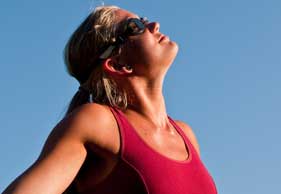These days
most of us are aware that being exposed to sunshine has great health benefits,
but there are also potential dangers from being exposed to too much sun, yet
many of us forget the sunscreen when doing a long run or race. That’s why
Johannesburg dermatologist and four-time Comrades Marathon finisher, Dr Gary
Levy, urges athletes to apply sunscreen generously and properly at all times!
“The skin
is good at repairing itself once you burn – it takes between 30 to 60 days – but
once you burn again, the repairing process in the skin gets damaged and your
skin doesn’t repair 100 percent anymore, but rather at 99 percent,” says Dr
Levy. “Then when you burn again, it will repair itself at say, 98 percent, and
so the process of skin damage has begun. This is when you get your brown spots
and cancerous sores. In particular, ladies don’t realise how much damage they
inflict on their legs by tanning them – I have a lot of female patients with
sun spots on their legs. You just need 20 minutes in the sun, three times a
week, to promote your health, but during this time you should still be wearing
sunscreen.”
SPF EXPLAINED
Now the sun
protection factor (SPF) of a sunscreen does not indicate the strength or level
of protection you will enjoy, but rather the length of protection. “Different
skin types have different sun tolerance levels: A very light-skinned person
will normally start turning red within two minutes, whereas a dark-skinned person
takes much longer, so if you have a light skin tone, you should use a higher
SPF. If you turn red in two minutes and you use an SPF15, it will ‘buy you’ 30
minutes in the sun,” explains Dr Levy.
He therefore
recommends that athletes should wear protective clothing on races that go over
two hours, and should also make it a priority to carry sunscreen and reapply it
every two to three hours, depending on skin tone. “Athletes with a light skin
tone should opt for at least SPF30, and darker toned people should not think
they are not at risk of skin damage, since the only difference is that
cancerous cells develop slower in darker toned skin. Also, as athletes you rub
or sweat the sunscreen off, and even waterproof sunscreen doesn’t guarantee you
full protection – it will last you 45 minutes in water and that is only if you
don’t rub it off.”
CHECK YOUR SKIN
There are two
types of skin cancer you need to look out for. The first sign of non-melanoma
skin cancer is usually the appearance of a lump or patch on the skin that
doesn’t heal after a few weeks. Melanoma itself is more dangerous and if left
too late, can be fatal. This is why we need to check all those beauty spots or
moles! The simple way to check a mole is with the ABCD method:
A is for Asymmetry: Normal
moles or freckles are completely symmetrical. If you draw a line through a
normal spot, you would have two identical halves. In cases of skin cancer,
spots will not look the same on both sides.
B is for Border: A mole or spot should be nice and round, so look for blurry
or jagged edges.
C is for Colour: It shouldn’t be more than two colours.
D is for Diameter: If it is
larger than a pencil eraser (6mm), it needs to be examined by a doctor.


